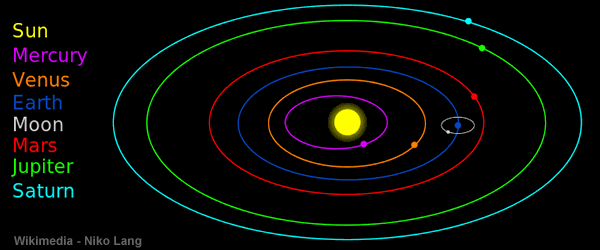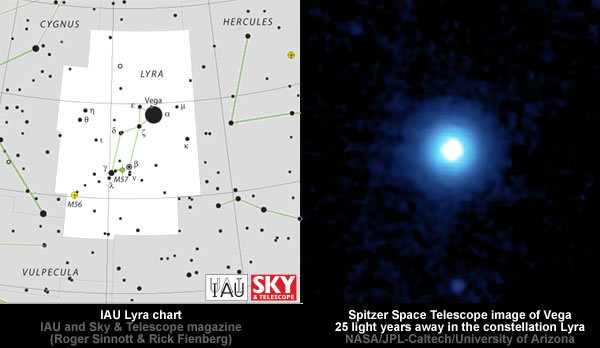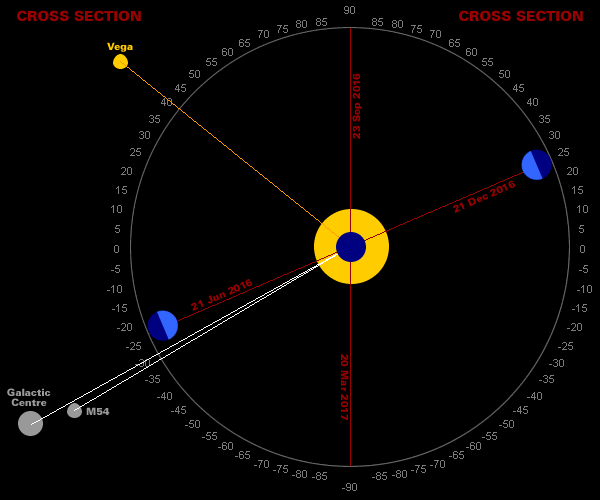WARNING
If you like your Science Settled or your History served with a thick Gradualist Gloss then you should stop reading now and retreat to your preferred Safe Space.
Early in the 17th century Galileo Galilei discovered the Milky Way was more than a “band of light”.
Galileo Galilei first resolved the band of light into individual stars with his telescope in 1610.
Until the early 1920s, most astronomers thought that the Milky Way contained all the stars in the Universe. Following the 1920 Great Debate between the astronomers Harlow Shapley and Heber Curtis, observations by Edwin Hubble showed that the Milky Way is just one of many galaxies – now estimated to number as many as 200 billion galaxies in the observable universe
Later in the 17th century Isaac Newton mathematically conjured up “universal gravitation”.
In 1687, English mathematician Sir Isaac Newton published Principia, which hypothesizes the inverse-square law of universal gravitation.
In his own words, “I deduced that the forces which keep the planets in their orbs must [be] reciprocally as the squares of their distances from the centers about which they revolve: and thereby compared the force requisite to keep the Moon in her Orb with the force of gravity at the surface of the Earth; and found them answer pretty nearly.”
But Newton’s “universal gravitation” is falsified by the Milky Way Rotation Curve.
Extra-fast stars:
Stars in galaxies follow a distribution of velocities where stars on the outskirts are moving faster than they should according to the observed distributions of normal matter.
Galaxies within galaxy clusters show a similar pattern.
The falsification of Newton’s “universal gravitation” [on a truly galactic scale] has encouraged the mainstream to exclude galaxies from their diagrams of elliptical orbits in the Solar System.
The following diagram shows the relation between the line of solstice and the line of apsides of Earth’s elliptical orbit.
The orbital ellipse goes through each of the six Earth images, which are sequentially the perihelion (periapsis – nearest point to the Sun) on anywhere from January 2 to January 5, the point of March equinox on March 19, 20, or 21, the point of June solstice on June 20,21, or 22, the aphelion (apoapsis – farthest point from the Sun) on anywhere from July 3 to July 5, the September equinox on September 22, 23, or 24, and the December solstice on December 21,22, or 23.
Note that the diagram shows an exaggerated representation of the shape of Earth’s orbit.
The actual path of Earth’s orbit is not as eccentric as that portrayed in the diagram.
This omission only reinforces the fact that the mainstream have no mechanics for their neatly diagrammed orbital ellipses because the second focus [of the ellipse] is absent i.e. a ghost.
See: https://malagabay.wordpress.com/2013/02/28/the-flowering-of-celestial-mechanics/
Therefore, in the interests of science, let’s construct a couple of orbital diagrams for the Earth [using mainstream astronomical coordinates] that include the Sun, Vega and the galactic centres of the two candidates for the Our Galaxy designation.
Journey to the Center of the Galaxy – Angelle Tanner
http://www.astro.ucla.edu/~tanner/gcintro.htmlCoordinates: 17h 45m 40.04s, −29° 00′ 28.1″
https://en.wikipedia.org/wiki/Galactic_centreCoordinates: 18h 55m 03.28s, −30° 28′ 42.6″
https://en.wikipedia.org/wiki/Messier_54Coordinates: 18h 36m 56.3364s, +38° 47′ 01.291″
https://en.wikipedia.org/wiki/VegaThe Apex of the Sun’s Way, or the solar apex, is the direction that the Sun travels relative to other nearby stars. This motion is towards a point in the constellation Hercules, near the star Vega.
The results are startling.
Firstly, the plan view of the Earth’s orbit reveals that Aphelion [which occurs in early July] aligns with M54 at the “core” of the Sagittarius Dwarf Spheroidal Galaxy.
The Sagittarius Dwarf Spheroidal Galaxy (Sgr dSph), also known as the Sagittarius Dwarf Elliptical Galaxy (Sgr dE or Sag DEG), is an elliptical loop-shaped satellite galaxy of the Milky Way.
…
Sgr dSph has four known globular clusters with one, M54, apparently residing at its core.https://en.wikipedia.org/wiki/Sagittarius_Dwarf_Elliptical_Galaxy
Secondly, the side elevation [aka cross section] of the Earth’s orbit reveals that the Sun [and hence the Solar System] is “travelling in a polar orbit (i.e. an orbit passing over the Milky Way’s galactic poles)” and this trajectory clearly suggests the Sagittarius Dwarf Spheroidal Galaxy wins the Our Galaxy designation competition.
The Sagittarius Dwarf Spheroidal Galaxy (Sgr dSph), also known as the Sagittarius Dwarf Elliptical Galaxy (Sgr dE or Sag DEG), is an elliptical loop-shaped satellite galaxy of the Milky Way.
It consists of four globular clusters, the main cluster having been discovered in 1994.
Sgr dSph is roughly 10,000 light-years in diameter, and is currently about 70,000 light-years from Earth, travelling in a polar orbit (i.e. an orbit passing over the Milky Way’s galactic poles) at a distance of about 50,000 light-years from the core of the Milky Way (about 1/3 the distance of the Large Magellanic Cloud).
In its looping, spiraling path, it has passed through the plane of the Milky Way several times in the past.
https://en.wikipedia.org/wiki/Sagittarius_Dwarf_Elliptical_Galaxy
“This first full-sky map of Sagittarius shows its extensive interaction with the Milky Way,” Majewski said. “Both stars and star clusters now in the outer parts of the Milky Way have been ‘stolen’ from Sagittarius as the gravitational forces of the Milky Way nibbled away at its dwarf companion. This one vivid example shows that the Milky Way grows by eating its smaller neighbors.”
The study’s map of M giants depicts 2 billion years of Sagittarius stripping by the Milky Way, and suggests that Sagittarius has reached a critical phase in what had been a slow dance of death.
“After slow, continuous gnawing by the Milky Way, Sagittarius has been whittled down to the point that it cannot hold itself together much longer,” said 2MASS Science Team member and study co-author Martin Weinberg of the University of Massachusetts. “We are seeing Sagittarius at the very end of its life as an intact system.”
“For only a few percent of its 240 million-year orbit around the Milky Way galaxy does our Solar System pass through the path of Sagittarius debris,” Majewski said. “Remarkably, stars from Sagittarius are now raining down onto our present position in the Milky Way. Stars from an alien galaxy are relatively near us. We have to re-think our assumptions about the Milky Way galaxy to account for this contamination.”
Scientists Now Know: We’re Not From Here!
Viewzone – Dan Eden – June 2007
http://viewzone.com/milkyway22.html
Thanks to Aldo Vitagliano [for the Solex software] and Michele Casati at http://daltonsminima.altervista.org [for the introductions] it’s possible to visualise a heliocentric view of the planets as they ride the Galactic Roller Coaster around the Sun.
Basically, SOLEX is a free computer program modelling the N-body dynamics of the Solar System, and it is the result of a long and patient amatorial work by the author (Aldo Vitagliano).
Its heart is a powerful numerical integrator, and the many additional functions make it a greatly flexible program, which at the same time is very simple to use and very powerful in its performances.
It can just give aesthetic pleasure and help in identifying sky objects, or it can be used by an experienced researcher as a tool to investigate aspects of the solar system dynamics such impact probabilities and chaotic motion.
Last but not least, the software package contains a companion orbit-determination program (EXORB), suitable for the determination of orbital elements of minor bodies (asteroids and comets) from their astrometric observations
SOLEX & EXORB – Orbits handling & determination software
Aldo Vitagliano
http://www.solexorb.it/
Clearly, Newton’s mathematical mass magic of “universal gravitation” is mechanically delusional.
See: https://malagabay.wordpress.com/2013/02/28/the-flowering-of-celestial-mechanics/
The Chemical Basis of Medical Climatology – Prof. Giorgio Piccardi – 1962
http://rexresearch.com/piccardi/piccardi.htm
Frankly, Mathematical Magic and Anaemic Academics “don’t impress me much”.
Okay, so you’re a rocket scientist,
That don’t impress me much
So you got the brain but have you got the touch
Songwriters: Robert John Lange, Shania Twain
Lyrics © Universal Music Publishing Group
















Pingback: Lawler Alignments – Galactic Interchange Ahead | MalagaBay
I am enjoying your work – although I’m pretty sure I don’t “get” a tenth of it.
You have probably seen this video and I’m not at all sure it’s on point but I thought I’d share anyways.
‘the Milky Way is just one of many galaxies – now estimated to number as many as 200 billion galaxies in the observable universe’
That puts the three-body problem in the shade.
http://en.wikipedia.org/wiki/Three-body_problem
🙂 🙂 🙂
Essential Guide to the EU – Chapter 10 Rotational Effects | thunderbolts.info
One of the reasons for the assumption of large amounts of Cryogenic (or Cold) Dark Matter (CDM) in the Gravity Model is to explain the observed rotation of galaxies. Astronomers have found that the individual stars in galaxies do not orbit the center of the galaxy in accordance with Kepler’s Laws for the motion of the planets. More specifically, the stars outside the central bulge of a galaxy all have approximately the same angular velocity, rotating more like a rigidly connected disk, but according to Kepler’s laws, the velocity should be less as distance from the center increases.
Faraday found (circa 1831-1832, from The Electric Life of Michael Faraday by Alan Hirshfeld, Walker & Co., 2006) that a metal disk rotating in a magnetic field aligned with the axis of the disk would cause an electric current to flow radially in the disk, so he invented the first generator, known as a Unipolar Inductor, or Faraday Generator. The effect eventually was proved to be a result of the Lorentz Force acting on the electrons in the disk as they moved across the magnetic field.
If the current is supplied by an external circuit, the disk is made to rotate by the same force now acting on the electrons in the current. Of course the rotational velocity of the disk sets up different forces which oppose the driving current, and a balance is reached between the two. This arrangement is known as a Faraday Motor.
Galaxies are known, through precise Faraday rotation measures (RM) of the polarization of the light they emit, to possess magnetic fields aligned with their axes of rotation, and they also have conducting plasma among their stars. Assuming that currents exist in the plane of the galaxy similar to the equatorial current sheet known to exist in the Solar System, then the conditions appear to be similar to that in a Unipolar Inductor or Faraday Motor. Of course the disk in this case is not rigid. The exact mode of rotation would depend on the balance between the radial driving current and the rotationally induced opposing current, as in a Faraday Motor, but it is at least possible that it is these electrical effects that are causing the anomalous rotation that we see, not some huge quantity of invisible Dark Matter.
In this context, it is interesting to see the recent discovery by the Sloan Digital Sky Survey of a ring of stars in the equatorial plane of the Milky Way but outside our galaxy. The similarity with a toroidal current around a pinch in a large Birkeland Current along the axis of the Milky Way suggests that once again electrical forces on a galactic scale may be responsible for the formations we see.
Structures similar to Faraday Motors have been observed in nebulae as well. One of the most obvious examples is in the Crab Nebula, where the Chandra X-ray image demonstrates very clearly all the required elements of an inductor or motor arrangement.
https://www.thunderbolts.info/wp/2012/02/29/essential-guide-to-the-eu-chapter-10/Michael
By the way, ikipedia is a terrible source for information. For example, you will not find a word about the Electric Universe Theory on their website, even though it was posted once. They deleted it, and will not allow a word to be posted in support of it. Ikipedia only allows consensus views to be posted.
You’d do well to avoid using Ikipedia as a source. Just sayin’.
As for helical motion in the Universe:
Birkeland currents transport electric charges through space along twisting electromagnetic filaments that can span intergalactic distances. They are seen at all cosmic scales because almost every celestial object in the Universe is filamentary. Planetary nebulae are webs of lighted tendrils; energetic galaxies emit braided jets, while some galaxies display threads of material extending for many light-years.
The cosmos is spun from those interacting filaments, each composed of helical Birkeland currents. Power in the circuits is converted from electricity into rotational energy, otherwise known as angular momentum, so galaxies spin because they are electric motors driven by power lines. They should be evaluated according to electrodynamic principles.
https://www.thunderbolts.info/wp/2016/05/23/a-fox-in-the-henhouse/
Filamentary, my dear Watson.
Pingback: Lawler Alignments – The Galactic Tide | MalagaBay
The plane of our solar system is at a 60 degree angle to the galactic plane. That means, that our planets rotate around the sun askew to the galactic plane from an outside view.
– shouldn’t all plantes rotate in the same plane around the galactic center and around their stars?
– since we are rotating at the wrong angle – don’t we even belong to the milky way galaxy?
– the exoplanets so far are found in two groups. Either rotating at an angle of about 90 degrees or at any angle. The second group is close to us. The first group are the stars further away from us (200 ly+)
– stars in globular clusters are swarming in random directions, their planetes presumeably rotate accordingly at any angle (from our point of view).
Conclusion: We belong to a group of near stars where planets have all kinds of rotation angles which should be normal for planets in globular clusters.
Pingback: The Atomic Comet: Self-Propelled Footnote | MalagaBay
Pingback: Parallax Problems | MalagaBay